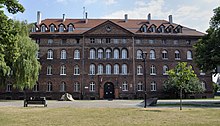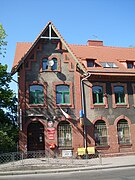
The economy of Poland is an emerging and developing, high-income, industrialized, mixed economy that serves as the sixth-largest in the European Union by nominal GDP and fifth-largest by GDP (PPP). Poland boasts the extensive public services characteristic of most developed economies and is one of few countries in Europe to provide no tuition fees for undergraduate and postgraduate education and with universal public healthcare that is free at a point of use. Since 1988, Poland has pursued a policy of economic liberalisation but retained an advanced public welfare system. It ranks 20th worldwide in terms of GDP (PPP), 21st in terms of GDP (nominal), and 21st in the 2023 Economic Complexity Index. Among OECD nations, Poland has a highly efficient and strong social security system; social expenditure stood at roughly 22.7% of GDP.

Alwernia is a town situated some 36 kilometres west of Kraków in the Chrzanów County, Lesser Poland Voivodeship, Poland. The town has an area of 8.88 square kilometres, and as of June 2022 it has a population of 3,284.
Poste restante, also known as general delivery in North American English, is a service where the post office holds the mail until the recipient calls for it. It is a common destination for mail for people who are visiting a particular location and have no need, or no way, of having mail delivered directly to their place of residence at that time.
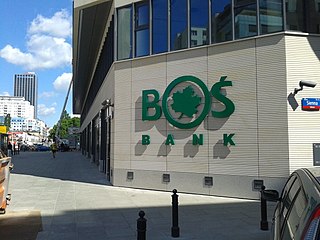
Bank Ochrony Środowiska S.A. started operations in 1991. It specializes in supporting undertakings and activities contributing to environmental protection. As of 2015, BOŚ S.A. allocated approximately 15,1 billion PLN for the financing of ecological projects, only in 2014 the total amount of loans for pro-ecological projects exceeded 1,9 billion PLN. Implementation of investments for environmental protection, credited by the bank and completed in 2014, contributed to significant environmental effects.

Orlen S.A., commonly known as Orlen, is a Polish multinational oil refiner, petrol retailer and natural gas trader headquartered in Płock, Poland. The company's subsidiaries include the main oil and gas companies of the Czech Republic and Lithuania, Unipetrol and Orlen Lietuva respectively.
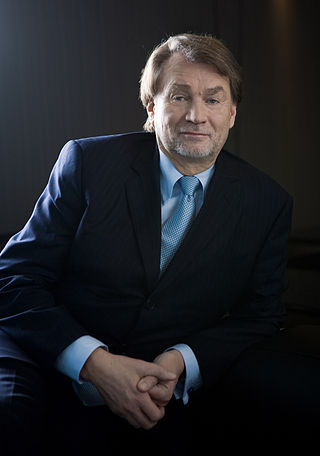
Jan Jerzy Kulczyk was a Polish billionaire businessman. He was the founder and owner of Kulczyk Holding and an international investment house Kulczyk Investments with headquarters in Luxembourg and offices in London and Kyiv, Ukraine. According to Forbes, Kulczyk was the richest Pole at the time of his death.

Orange Polska is a Polish telecommunications provider established in December 1991. It is a public company traded on the Warsaw Stock Exchange, with a controlling stake owned by Orange S.A., the latter controlling over 50% of this stake by 2002. It operates the following services: PSTN, ISDN, GSM 900/1800 network, ADSL, IDSL, FTTH fibre Internet, Frame Relay, ATM and Inmarsat.

Santander Bank Polska SA, formerly Bank Zachodni WBK (BZ WBK) (eng. West WBK Bank - the WBK abbreviation below) is a Polish universal bank based in Wrocław, Poznań and Warsaw. It is the third largest bank in Poland in terms of assets value and the number of outlets. It was formed in 2001 by the merger of Bank Zachodni S.A. and Wielkopolski Bank Kredytowy SA. Since 2011, the Bank has been owned by the Spanish bank Santander Group.
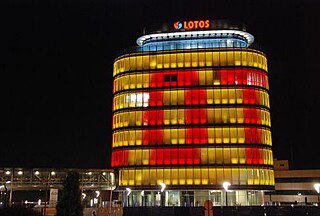
Grupa Lotos S.A. was a vertically integrated oil company based in Gdańsk, Poland. The company was listed in the Polish index WIG30. The Polish state was the majority shareholder with 53% percent. The company's main activity branches were: crude oil production, refining and marketing of oil products. The company was a leader in lubricants on the Polish market. Grupa Lotos was a producer of unleaded gasoline, diesel, fuel oils, aviation fuels, motor and industrial lubricants, bitumens and waxes.

Złota 44 is a residential skyscraper in central Warsaw, Poland. It was designed by Polish-American architect Daniel Libeskind, in association with Polish architects Artchitecture. It was developed by US real estate investment manager Amstar and Warsaw developer BBI Development, which bought the topped-out but unfinished building from its initial developer, ORCO. The building is sometimes referred to as Żagiel although the skyscraper's architect drew inspiration for Złota 44 from the shape of an eagle's wing symbolizing changing Warsaw, Poland and freedom.
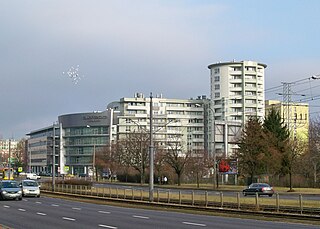
Asseco Poland SA is a Polish multinational software company which develops enterprise software primarily for the banking and finance industries. It was founded in 1991, and its headquarters are located in Rzeszów, Subcarpathian Voivodeship, Poland. Asseco is one of the largest corporations in the technology sector quoted on the Warsaw Stock Exchange (WSE) and is a component of the WIG30 stock market index. It operates in 60 countries worldwide and employs over 32,400 people. As of 2023, the largest shareholder of the company is Cyfrowy Polsat with 22.95% of the shares ahead of OFE Allianz Polska with 10.82% of the shares.

Bank Polska Kasa Opieki Spółka Akcyjna, commonly using the shorter name Bank Pekao S.A., is a universal bank and currently the second largest bank in Poland with its headquarters in Warsaw. The Italian bank UniCredit used to own 59% of the company. It sold the bank in December 2016. Now Powszechny Zakład Ubezpieczeń owns 20% of the company, Polish Development Fund 12.80%, UniCredit 6.28% and others 60.94%.

Bank Millennium S.A. is a Poland-based commercial bank with headquarters in Warsaw, and owned by the Portuguese bank Millennium BCP. It is one of the largest banks in Poland and has been operating for 35 years. In 2018, it was the 7th bank in Poland in terms of asset value.

In Poland, postal codes were introduced in 1973. They are five-digit codes of two-then-three digits, with a hyphen between them. The first digit indicates one of the 10 large postal regions the country is divided into. These areas do not follow the administrative divisions. The second and third digits specify a particular smaller region, and the last two are the number of a postal delivery branch.
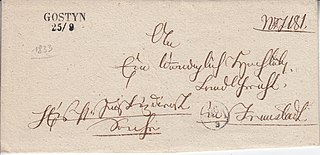
Poczta Polska, the Polish postal service, was founded in 1558 and postal markings were first introduced in 1764. The three partitions of Poland in 1772, 1793 and 1795 saw the independent nation of Poland disappear. The postal services in the areas occupied by Germany and Austria were absorbed into those countries' postal services. In 1772 the area occupied by Austria was created into the Kingdom of Galicia, a part of the Austrian Empire. This lasted till 1918. The Duchy of Warsaw was created briefly, between 1807 and 1813, by Napoleon I of France, from Polish lands ceded by the Kingdom of Prussia under the terms of the Treaties of Tilsit. In 1815, following Napoleons' defeat in 1813, the Congress of Vienna, created Congress Poland out of the Duchy of Warsaw and also established the Free City of Kraków. Congress Poland was placed under the control of Russia and the postal service was given autonomy in 1815. In 1851 the postal service was put under the control of the Russian post office department regional office in St Petersburg. In 1855 control was restored for a while to the Congress Kingdom but following the uprising in 1863 again came under Russian control from 1866 and continued until World War I. In November 1918 the Second Polish Republic was created.

Italy–Poland relations are cultural and political relations between Italy and Poland. The strong historical ties between both countries, such as the Roman Catholic religion and common fights for independence, have caused many to call the relationship the Polish–Italian brotherhood.

Sebastiano Montelupi, was an Italian-born merchant and banker in Kraków, Poland, and Postmaster General of the Polish royal postal service under Sigismund II Augustus, Henry III of Poland, Anna Jagiellon, Stephen Báthory and Sigismund III Vasa.
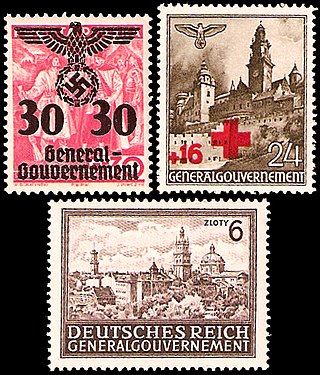
Postal communication in the General Government, previously provided by the Polish Post, were taken over by the German postal service (Reichspost) after the invasion of Poland and the establishment of the General Government in 1939, and then in 1941 in additional areas of eastern Poland.

Venture capital in Poland is a segment of the private equity market that finances early-stage high-risk companies based in Poland, with the potential for fast growth. As of March 2019, there is a total of 130 active VC firms in Poland, including local offices of international VC firms, and VC firms with mainly Polish management teams. Between 2009–2019, these entities have invested locally in over 750 companies, which gives an average of around 9 companies per portfolio. The Polish venture market accounts for 3% of the entire European ecosystem of VC investments, mainly in the digital space.
Beesfund is a Polish equity crowdfunding platform based in Warsaw, Poland. Managed by its eponymous company founded in 2012 by entrepreneur Arkadiusz Regiec, it is one of the first crowdfunding platforms in Poland, and Central and Eastern Europe. As of May 2020, 74 public offerings (issuances) were carried out on the platform, for a total amount of PLN 47M, collected by over 48,000 registered investors.





